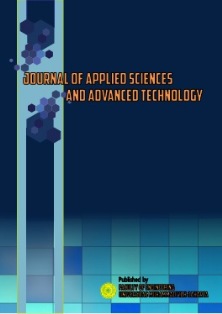The Effect of Oil Thickness in the Cylindrical Settling Tank on the Moisture and Impurities of Crude Palm Oil (CPO)
DOI:
https://doi.org/10.24853/jasat.3.1.21-28Keywords:
Cylindrical Settling Tank, Skimmer, Moisture Content, Dirt ContentAbstract
Cylindrical Settling Tank (CST) is a unit of clarification station that functions as a process of placing and extracting / extracting palm oil using the under flow and upper flow processes of palm oil. A clarification station is a station in a palm oil mill which functions to separate oil, water, sludge and other objects involved in the refining process of palm oil. This process aims to obtain clean palm oil and avoid dirt and water levels during the extraction process. The higher / thicker the oil layer is taken, it will affect the quality of the palm oil obtained, so it is carried out by taking palm oil slowly (laminar flow). Taking the height / thickness of palm oil is carried out on a skimmer unit that can rise and fall from the surface of the palm oil using a screw system. The results of taking the height / height of palm oil from the level of 20 cm, 30 cm, and 40 cm with the average yield of water content and CST feed impurities are 29.125% and 38.931%, the average output of the Skimmer for moisture and moisture content. the impurities are 1.039% and 0.089%. The mean wet oil tank output was 0.956% and 0.037%, and the mean moisture content and dirt content of the vaccum drier were 0.196% and 0.021%.Downloads
References
Davis L. TaggartRussell L. McGalliardRalph R. EgurenDavid G. Hild, 1992, Method of oil/water separation utilizing coalescing bodies, United State Patent, 1992.
Hasibuan, Pinayungan 2016, Analisa Reliability, Maintainability Dan Availability Untuk Meningkatkan Efektivitas Dan Efesiensi Sterilizer Di Pabrik Kelapa Sawit. Tugas Akhir Mahasiswa STIPAP Program Studi Teknologi Pengolahan Hasil Perkebunan.
Hudori, M (2011) Analisa Faktor Penyebab Tingginya Kadar Kotoran pada Produksi Minyak Kelapa Sawit, Vol 3 No 1 (2011): JCWE Edisi Mei 2011
Kashi, Rahma Yuliati ; Edy Widodo (2019), Pengendalian Kualitas Crude Palm Oil (CPO) Dengan Diagram Kontrol Multivariat Exponatially Weighted Moving Avarage (MEWMA), Vol 2 (2019): PRISMA, Prosiding Seminar Nasional Matematika, 848-853.
Kristono, St. Nugroho, Istianto Budhi Rahardja, Anita Rahayu, 2011, Analisa Pengaruh Retention Time Terhadap Persentase Kadar Kotoran Pada Crude Palm Oil (CPO), Jurnal Citra Widya Edukasi, Vol.3, No2, 2011, page 20-30.
Mahfud, Ahmad, 2017, Rancang Bangun Sensor Pelampung untuk Mendeteksi Ketebalan Lapisan Fluida di Continuous Settling Tank dengan Memanfaatkan Sensor Magnet (Reed Switch), Industrial Engeneering Journal, Universitas Malikusaleh, Vol 6, No 2 (2017), 17-22.
Naibaho, Ir. Ponten, 1998. Teknologi Pengolahan Kelapa Sawit. Medan : PPKS
Pardamean, Maruli, 2008, Panduan Lengkap Pengelolaan Kebun dan Pabrik Kelapa Sawit,Penerbit Agromedia Pustaka, Jakarta.
Rahardja, Istianto Budhi, Sulistiono Sulistiono, Anwar Ilmar Ramadhan, 2020, Identification of Palm Oil Mill Throughput Capacity of 60 tons/hour (Case Study at XYZ Palm Oil Mill), Journal of Applied Sciences and Advanced Technology, Vol. 2, No.3, (2020), page 83-86.
Syahreza, M.Amri, 2018, Analisa dan Identifikasi Kegagalan pada Stasiun Klarifikasi Menggunakan Metode Overall Equipment Effectiveness (OEE) dan Failure Mode and Effect Analysis (FMEA) di PTPN IV PKS Adolina, Tugas Akhir, Universitas Sumatera Utara.
Downloads
Published
Issue
Section
License
COPYRIGHT POLICY
The author(s) of an article published in the Journal of Applied Sciences and Advanced Technology (JASAT) retains ownership of the intellectual property rights in work (s).
PUBLISHING RIGHTS
The author(s) of an article published in the Journal of Applied Sciences and Advanced Technology (JASAT) have unrestricted publication rights. The authors give the Journal of Applied Sciences and Advanced Technology (JASAT) the right to publish the article and designate the Faculty of Engineering Universitas Muhammadiyah Jakarta Publishing as the original publisher of the article.
LICENSING POLICY
JASAT is an open-access journal that follows the Creative Commons Non-Commercial 4.0 International License (CC BY-NC 4.0), which states that:

Under this license, the reusers must give appropriate credit, provide a link to the license, and indicate if changes were made. Users may do so in any reasonable manner, but not in any way that suggests the licensor endorses users or their use.
Please take the time to read the whole license agreement (https://creativecommons.org/licenses/by-nc/4.0/). As long as reusers follow the license conditions, the owner cannot withdraw these freedoms. The following components are included under this license:
 Attribution: Users must provide appropriate attribution, including a link to the license, and indicate whether or not they made any modifications. Users are free to do so reasonably, but not in a manner that indicates the licensee approves of their usage.
Attribution: Users must provide appropriate attribution, including a link to the license, and indicate whether or not they made any modifications. Users are free to do so reasonably, but not in a manner that indicates the licensee approves of their usage.
 NonCommercial: Users may not use the material for commercial purposes.
NonCommercial: Users may not use the material for commercial purposes.












_2.png)


1.png)

2.png)
